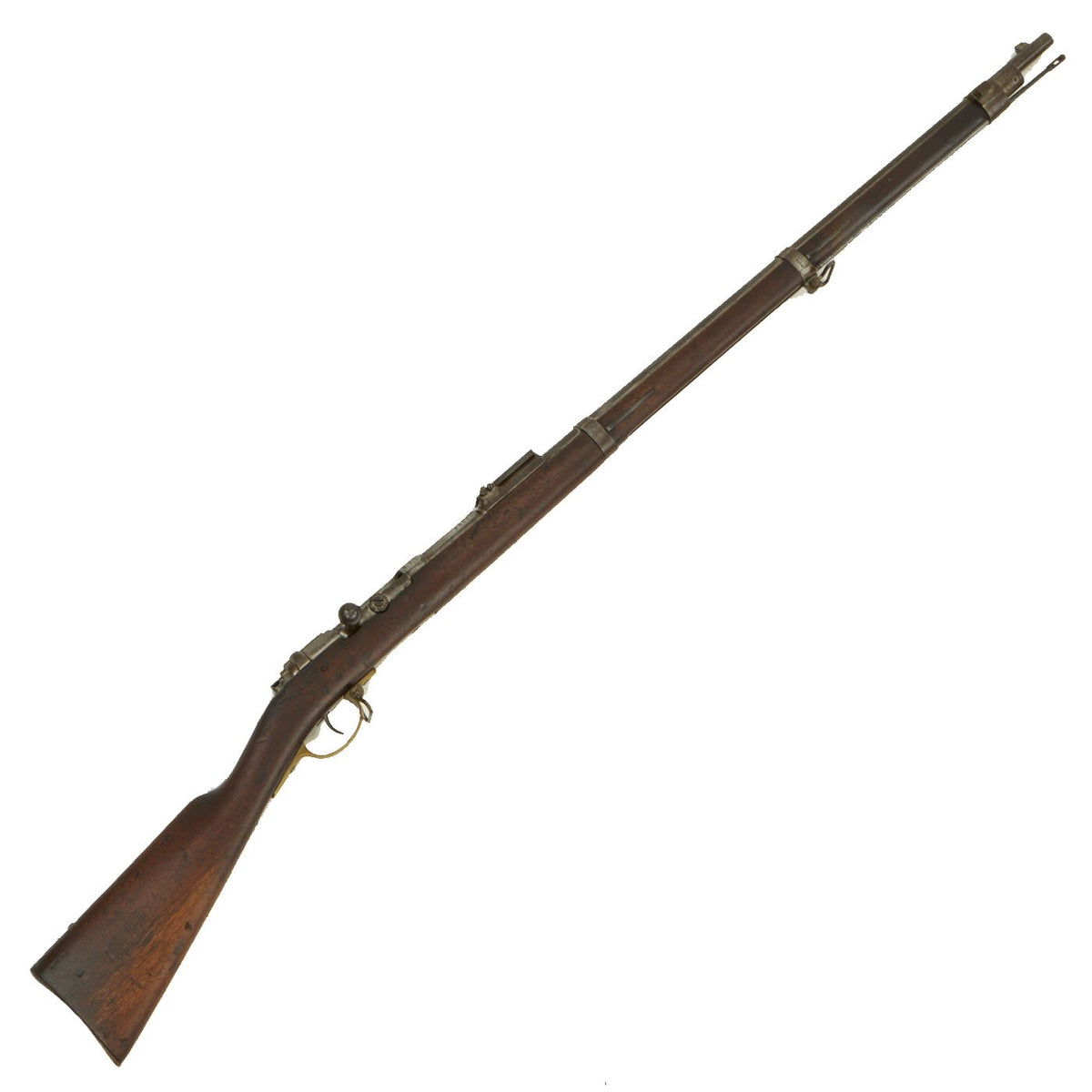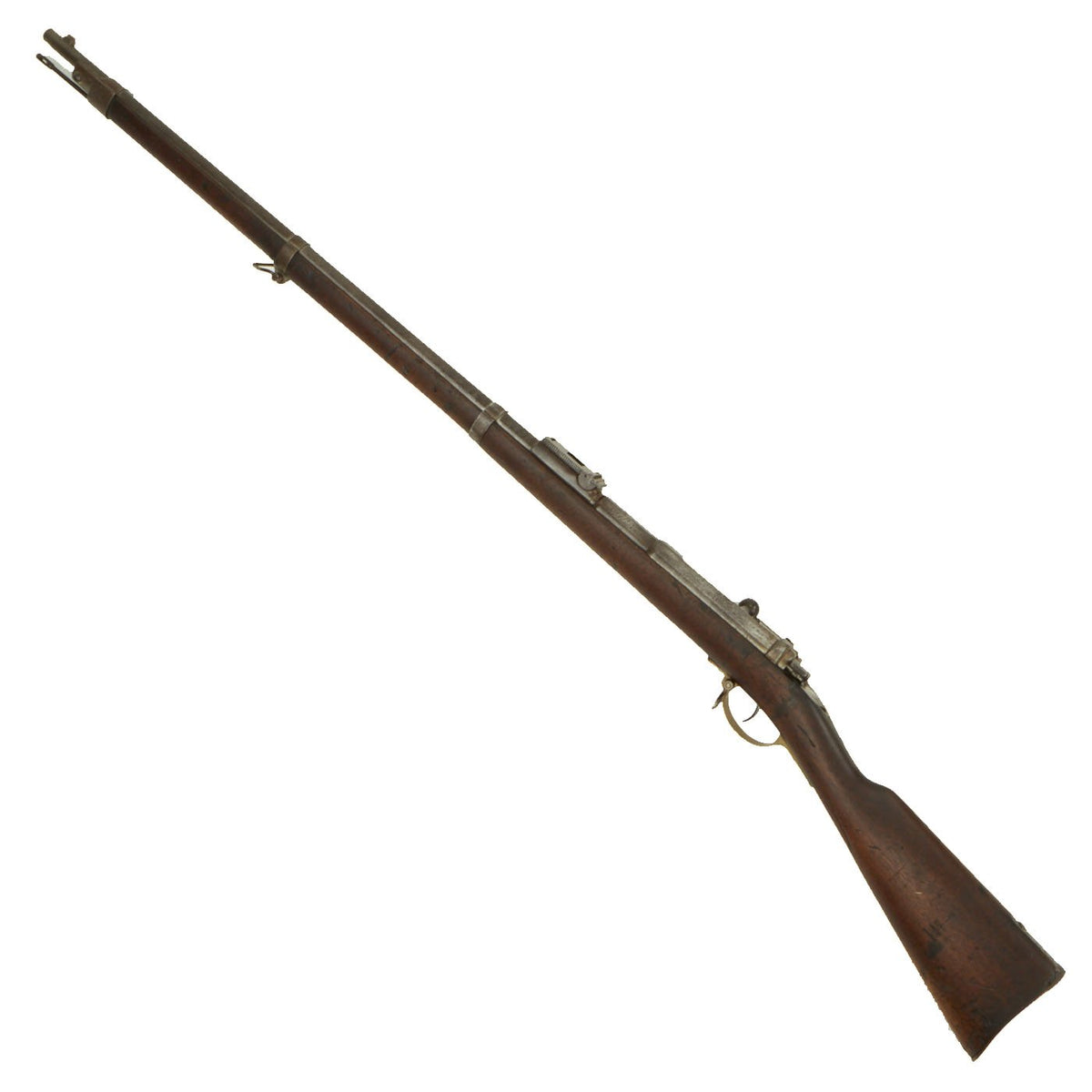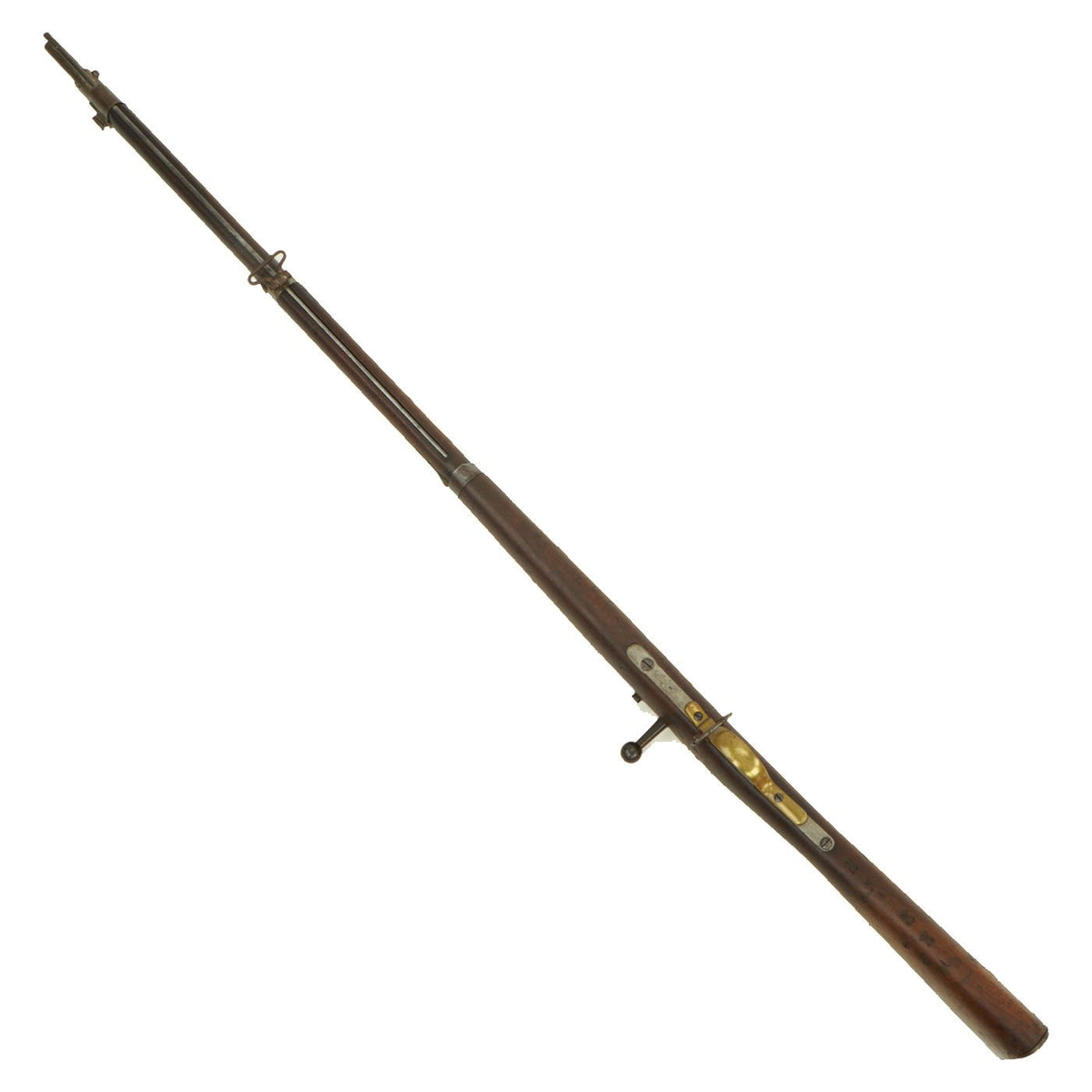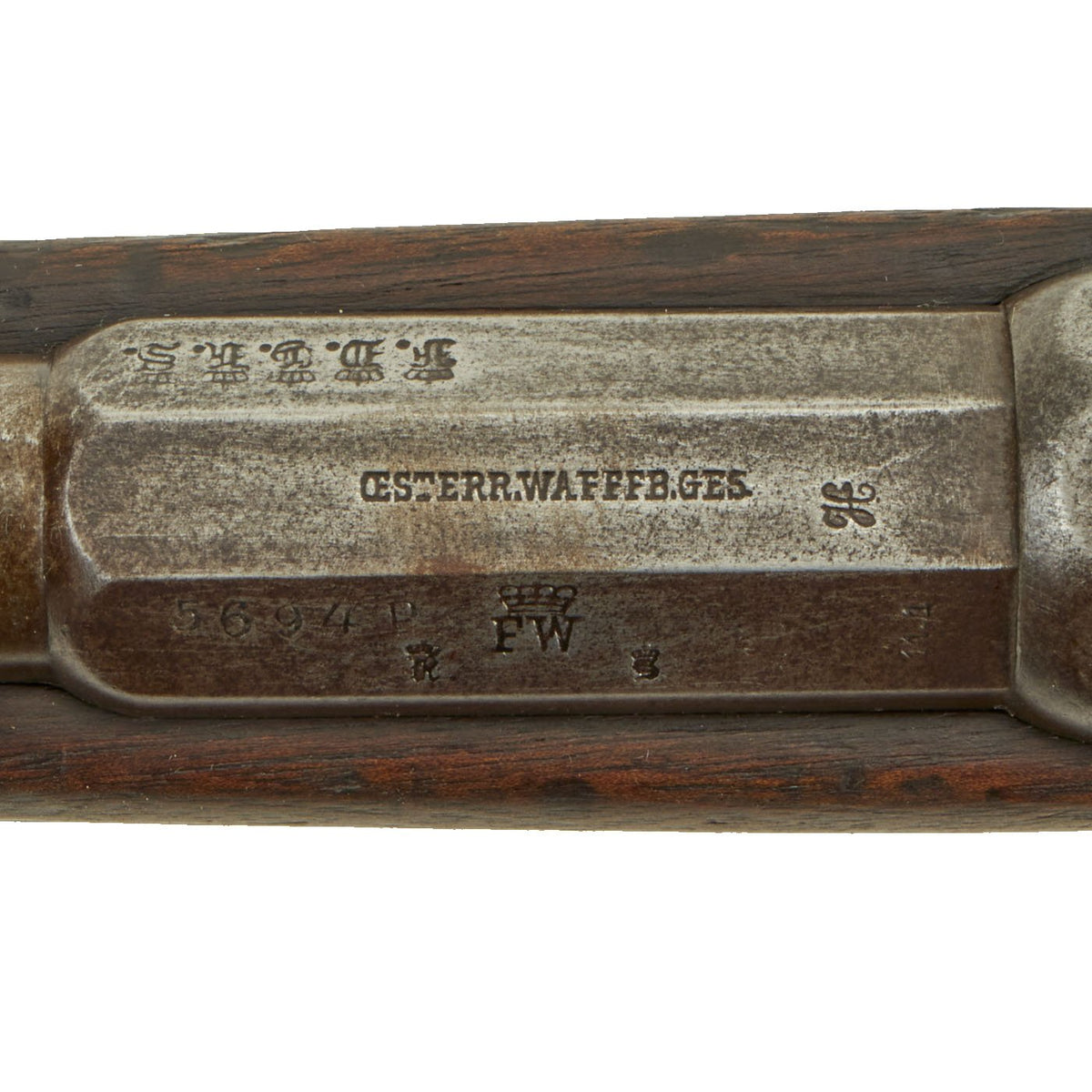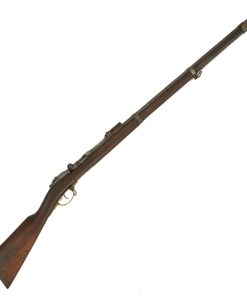Original German Mauser Model 1871 Infantry Rifle by ŒWG Steyr dated 1873 with Bavarian Markings – Serial 5694P Original Items
$ 1.695,00 $ 423,75
Original Item: Only One Available. This is a very nice example of the Mauser Model 1871 Infantry Rifle, manufactured by the famous ŒWG Steyr in Austria. It is covered with Imperial German inspection and acceptance markings on the metalwork. It bears serial number 5694P on the barrel, receiver, bolt, and just about every other part that would have a serial number except for the butt plate and a few screws, which are non-matching.
The receiver is dated 1873. and marked I. G. Mod. 71 on the opposite side in German “Black Letter” type. This stands for Infanterie Gewehr (Infantry Rifle) Model 71. The top of the barrel nocks form is marked ŒSTERR. WAFFFB. GES., an abbreviation of “Österreichische Waffenfabriksgesellschaft”, or the Austrian Arms-Manufacturing Company. Part of ŒWG was Steyr-Mannlicher, known mainly as Steyr, who continue to make firearms to this day. Below this is the Crown over FW proof for Kaiser Wilhelm I, who used the F.W. monogram.
The butt plate tang bears regimental marking B. 2. P. E. 1. 149., which stands for the 2nd Royal Bavarian Pioneer / Engineers, Ersatz (Replacement) Battalion, 1st Squadron, 149th Weapon. This rifle does not appear to have been re-issued for reserve use later on.
The Rifle comes complete with cleaning rod and is in good condition overall. Interestingly, it has a brass trigger guard installed. The rifle still has both sling swivels intact. The exterior metal finish shows years of cleaning, and now has a lovely gray speckled patina. The bore is in very good condition, with strong lands and grooves, and a mostly bright finish. There is some light fouling and oxidation in the grooves, so it did see some level of use in service.
The stock looks very nice, and does not look to have been arsenal reconditioned, so the markings are still crisp. There are the expected dents and dings from service, as well as many decades of storage.
Overall this is an very nice example of a German Mauser model 1871 by Steyr, complete with regimental markings. The perfect addition to any German Mauser collection!
Specifications:-
Year of Manufacture: 1873
Caliber: 11x60mmR Mauser
Cartridge Type: Centerfire Cartridge
Barrel Length: 33.5 inches
Overall Length: 53 Inches
Action type: Bolt-Action
Feed System: Single Shot
History of the Mauser 1871
Adopted as the Gewehr 71 or Infanterie-Gewehr 71, or “Infantry Rifle 71 (“I.G.Mod.71” was stamped on the rifles themselves) was the first rifle model in a distinguished line designed and manufactured by Paul Mauser and Wilhelm Mauser of the Mauser company and later mass-produced at Spandau arsenal.
Paul Mauser developed his bolt-action rifle from 1866 to 1871. During 1870-71 trials with many different rifles took place, with the “M1869 Bavarian Werder” being the Mausers’ chief competitor. The Mauser was provisionally adopted on 2 December 1871, pending the development of an appropriate safety. With support from the government’s Spandau arsenal, the improvements to the safety mechanism were completed and the rifle was formally accepted on 14 February 1872 as Infantry Rifle Model 1871 by the German Empire excluding Bavaria. The action was not based on its predecessor, the Dreyse needle gun which had seen service during the Franco-Prussian War of 1870-71, and which was found to have a number of weaknesses.
The now well known Mauser “wing” type safety lever was developed for the Gewehr 71. The Gewehr 71 is a conventional looking bolt action chambered in 11mm using black powder cartridges. The action included only a bolt guide rib as its single locking lug, locking forward of the receiving bridge. The original design was a single-shot. The design was updated in 1884 with an 8-round tubular magazine designed by Alfred von Kropatschek, making this Germany’s first repeating rifle. This version was designated the Gewehr 1871/84. A version of this repeater was adopted by the Ottoman Empire. Designated the M1887, it differentiated from the M71/84 in that it had a side mounted cleaning rod, a second locking lug on the rear of the bolt, and it was in caliber 9.5×60mmR, which Paul Mauser touted as the most efficient (black powder) cartridge. In the early 20th century a few were converted to 7.65×53mm smokeless by the arsenal in Ankara.
NOTE: International orders of antique firearms MUST be shipped using UPS WW Services (courier). USPS Priority Mail international will not accept these. International customers should always consult their country’s antique gun laws prior to ordering.
Fast Shipping with Professional Packaging
Thanks to our longstanding association with UPS FedEx DHL, and other major international carriers, we are able to provide a range of shipping options. Our warehouse staff is expertly trained and will wrap your products according to our exact and precise specifications. Prior to shipping, your goods will be thoroughly examined and securely secured. We ship to thousands clients each day across multiple countries. This shows how we're dedicated to be the largest retailer on the internet. Warehouses and distribution centres can be located throughout Europe as well as the USA.
Note: Orders with more than one item will be assigned a processing date depending on the item.
Before shipping before shipping, we'll conduct a thorough inspection of the items you have ordered. Today, the majority of orders will be delivered within 48 hours. The delivery time will be between 3-7 days.
Returns
The stock is dynamic and we cannot completely manage it because multiple stakeholders are involved, including our factory and warehouse. So the actual stock may alter at any time. It's possible that you may not receive your order once the order has been made.
Our policy is valid for a period of 30 days. If you don't receive the product within 30 days, we are not able to issue a refund or an exchange.
You can only return an item if it is unused and in the same state as the day you received it. You must have the item in its original packaging.
Related products
Uncategorized
Uncategorized
Uncategorized
Uncategorized
Uncategorized
Uncategorized
Uncategorized
Uncategorized
Uncategorized
Uncategorized
Uncategorized
Uncategorized
Uncategorized
Angolan Rebel 1970s era 60mm Inert Display Mortar from Angolan Civil War Original Items
Uncategorized
Uncategorized
Uncategorized
